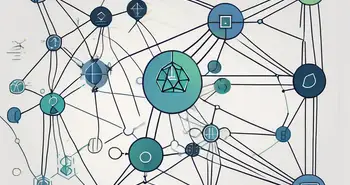Unpacking the Nakamoto Consensus: A Comprehensive Guide

As an expert in blockchain technology, I am thrilled to present to you a comprehensive guide on the Nakamoto Consensus. In this article, we will dive deep into the intricacies of this consensus mechanism and explore its important role in the world of cryptocurrencies. Strap in, as we embark on an enlightening journey into the fascinating world of the Nakamoto Consensus.
Understanding the Nakamoto Consensus
In order to comprehend the Nakamoto Consensus, it is crucial to understand its genesis. Satoshi Nakamoto, the enigmatic figure behind Bitcoin, introduced this consensus mechanism as a solution to the double-spending problem in decentralized digital currencies. By combining cryptography, decentralized networks, and economic incentives, Nakamoto Consensus achieved something revolutionary: it enabled a trustless and decentralized peer-to-peer system.
The Genesis of the Nakamoto Consensus
The Nakamoto Consensus was born out of Satoshi Nakamoto's groundbreaking white paper titled “Bitcoin: A Peer-to-Peer Electronic Cash System.” Released in 2008, this paper outlined the foundational concepts of Bitcoin, including the Nakamoto Consensus. Satoshi Nakamoto's genius lies in the ingenious way he brought together existing technologies and theories to create a novel solution for digital currencies.
Key Principles of the Nakamoto Consensus
The Nakamoto Consensus rests on a few core principles. First and foremost is the principle of proof-of-work, where miners compete to solve complex mathematical puzzles to validate transactions. This ensures that the network remains secure and resistant to attacks. Additionally, the consensus algorithm relies on the longest chain rule, where the chain with the most accumulated computational effort is considered the valid one. Finally, the Nakamoto Consensus promotes decentralization by allowing anyone to participate as a miner and validating transactions.
One of the key advantages of the Nakamoto Consensus is its ability to provide a high level of security. By requiring miners to solve complex mathematical puzzles, the consensus mechanism ensures that malicious actors would need an immense amount of computational power to alter the blockchain's history. This makes it highly unlikely for any single entity to gain control over the network and manipulate transactions for their own benefit.
Another fascinating aspect of the Nakamoto Consensus is its economic incentives. Miners who successfully validate transactions and add them to the blockchain are rewarded with newly minted cryptocurrency. This reward system not only encourages miners to participate in the network but also ensures the continuous operation and security of the blockchain. The economic incentives create a self-sustaining ecosystem where miners are motivated to act in the best interest of the network.
Furthermore, the Nakamoto Consensus has paved the way for the development of countless cryptocurrencies and blockchain-based applications. Its decentralized nature and trustless design have inspired innovators to explore new possibilities in various industries, from finance to supply chain management. This consensus mechanism has become the cornerstone of the blockchain revolution, enabling the creation of transparent and secure digital systems that can revolutionize the way we interact and transact.
The Role of the Nakamoto Consensus in Blockchain Technology
Now that we have a solid understanding of the Nakamoto Consensus, let's explore its essential role in blockchain technology.
The Connection Between Nakamoto Consensus and Blockchain
The Nakamoto Consensus is the driving force behind the security and immutability of blockchain networks. It ensures that transactions are validated, added to blocks, and appended to the blockchain in a transparent and trustworthy manner. The consensus mechanism's reliance on computational power and decentralized participation makes it extremely robust and resistant to manipulation.
How the Nakamoto Consensus Fuels Decentralization
Decentralization is one of the key advantages of the Nakamoto Consensus. Traditional centralized systems are vulnerable to single points of failure and censorship. In contrast, the Nakamoto Consensus distributes the control and decision-making power across a vast network of miners, resulting in a more resilient and censorship-resistant ecosystem. This decentralization empowers individuals and communities while reducing the reliance on centralized authorities.
The Mechanism of the Nakamoto Consensus
Having explored the significance of the Nakamoto Consensus, let's now shift our focus to the intricate mechanics of this consensus mechanism.
The Process of Transaction Verification
When a transaction is submitted to the network, miners compete to include it in the next block. They verify the transaction's validity by ensuring that the sender has sufficient funds and that the transaction adheres to the predefined protocol rules. This verification process is time-consuming and resource-intensive, ensuring that only legitimate transactions are added to the blockchain.
The Concept of Mining in the Nakamoto Consensus
Mining is the backbone of the Nakamoto Consensus. Miners dedicate their computational power to solving complex mathematical puzzles, a process known as mining. The first miner to solve the puzzle broadcasts their solution to the network, earning the right to add the next block to the blockchain. This process not only validates transactions but also generates new cryptocurrency tokens as a reward for the miner's efforts.
Strengths and Weaknesses of the Nakamoto Consensus
While the Nakamoto Consensus has revolutionized the world of cryptocurrencies, it is important to acknowledge its strengths and weaknesses.
Advantages of the Nakamoto Consensus
The Nakamoto Consensus offers several advantages that have contributed to its widespread adoption. Its decentralized nature ensures network resilience, making it difficult for malicious actors to manipulate the blockchain. Additionally, its proof-of-work mechanism provides a fair and secure way to validate transactions and maintain network security. Furthermore, the Nakamoto Consensus has inspired numerous blockchain applications, ranging from digital currencies to smart contracts and decentralized finance.
Potential Drawbacks and Criticisms
While the Nakamoto Consensus is a remarkable achievement, it is not without its shortcomings. The reliance on proof-of-work mining has raised concerns about its energy consumption and environmental impact. Furthermore, the Nakamoto Consensus may face scalability challenges as blockchain networks grow larger, leading to slower transaction times and higher fees. However, these challenges have spurred the development of alternative consensus algorithms, such as proof-of-stake, aimed at addressing these concerns.
The Future of the Nakamoto Consensus
As the world of blockchain technology continues to evolve, so does the Nakamoto Consensus. Let us explore what the future holds for this groundbreaking consensus mechanism.
Evolving Applications of the Nakamoto Consensus
The Nakamoto Consensus has already disrupted the financial sector, but its potential extends far beyond that. We are witnessing the emergence of decentralized applications (dApps) built on blockchain platforms that leverage the Nakamoto Consensus. These dApps provide innovative solutions across various industries, including supply chain management, healthcare, and governance. As the technology matures, we can expect even more exciting and transformative applications.
The Impact of Quantum Computing on the Nakamoto Consensus
One of the looming challenges for the Nakamoto Consensus is the advent of quantum computing. Quantum computers have the potential to break the cryptographic algorithms that underpin blockchain security. However, researchers and developers are actively exploring quantum-resistant algorithms and alternative consensus mechanisms to safeguard the future of decentralized systems. While the impact of quantum computing remains uncertain, the blockchain community remains proactive in addressing this potential threat.
To conclude, the Nakamoto Consensus is a groundbreaking achievement that laid the foundation for blockchain technology as we know it today. Its inherent decentralization and security have propelled the adoption of cryptocurrencies and inspired countless innovative applications. As we continue to unpack the Nakamoto Consensus and delve deeper into the world of decentralized systems, it is important to stay informed and actively participate in the exciting evolution of this technology.
FAQs
Q: What is the Nakamoto Consensus?
A: The Nakamoto Consensus is a consensus mechanism introduced by Satoshi Nakamoto in the Bitcoin white paper. It combines cryptography, decentralized networks, and economic incentives to create a trustless and decentralized system for validating transactions and securing blockchain networks.
Q: How does the Nakamoto Consensus ensure network security?
A: The Nakamoto Consensus relies on proof-of-work mining, where miners compete to solve complex mathematical puzzles. This computational effort ensures the security of the network by making it difficult and resource-intensive for malicious actors to manipulate the blockchain.
Q: What are the advantages of the Nakamoto Consensus?
A: The Nakamoto Consensus offers several advantages, including decentralization, network resilience, and the ability to create secure and transparent systems. It has also inspired the development of numerous blockchain applications beyond digital currencies.
Q: Is the Nakamoto Consensus energy-efficient?
A: The Nakamoto Consensus, as traditionally implemented with proof-of-work mining, has been criticized for its energy consumption. The process of solving complex mathematical puzzles requires significant computational power. However, alternative consensus algorithms, such as proof-of-stake, aim to address these concerns and reduce energy consumption.
Q: How will quantum computing impact the Nakamoto Consensus?
A: Quantum computing has the potential to break the cryptographic algorithms used in the Nakamoto Consensus. This poses a potential threat to blockchain security. However, the blockchain community is actively researching and developing quantum-resistant algorithms and alternative consensus mechanisms to safeguard the future of decentralized systems.
I hope this comprehensive guide has provided you with a deeper understanding of the Nakamoto Consensus and its significance in the world of blockchain technology. As an expert in the field, I encourage you to stay curious and explore the evolving landscape of decentralized systems. The future is bright and full of exciting possibilities!
As you've delved into the Nakamoto Consensus and its transformative impact on blockchain technology, why not take the next step and experience the future of trading with Morpher? Embrace the innovation that Morpher.com brings to investing, with its zero fees, infinite liquidity, and the ability to trade across a multitude of asset classes. Whether you're interested in cryptocurrencies, stocks, or even niche markets like NFTs, Morpher offers a unique, blockchain-powered platform that aligns perfectly with the decentralized ethos of the Nakamoto Consensus. Sign Up and Get Your Free Sign Up Bonus today to join a community of forward-thinking investors on a platform that's reshaping the world of trading.

Disclaimer: All investments involve risk, and the past performance of a security, industry, sector, market, financial product, trading strategy, or individual’s trading does not guarantee future results or returns. Investors are fully responsible for any investment decisions they make. Such decisions should be based solely on an evaluation of their financial circumstances, investment objectives, risk tolerance, and liquidity needs. This post does not constitute investment advice.

Painless trading for everyone
Hundreds of markets all in one place - Apple, Bitcoin, Gold, Watches, NFTs, Sneakers and so much more.

Painless trading for everyone
Hundreds of markets all in one place - Apple, Bitcoin, Gold, Watches, NFTs, Sneakers and so much more.









